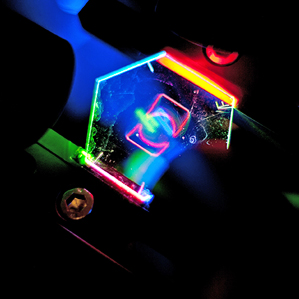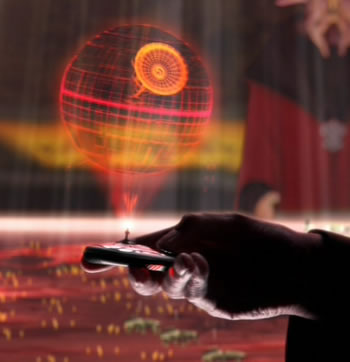Science Fiction
Dictionary
A B C D E F G H I J K L M N O P Q R S T U V W X Y Z
HP 3D Display Images Hover Above Device

HP Labs has developed a brand-new kind of 3D display that plays hologram-like videos without the need for any moving parts in the display, or special glasses worn by users. The videos displayed appear to hover above the screen; users can walk around them and experience an image or video from as many 200 different viewpoints. It's like walking around a real object.

(HP Logo hovers over display surface)
The screen is made by modifying a conventional liquid-crystal display (LCD), the same kind of display found in most phones, laptops, tablets, and televisions. Researchers hope these 3-D systems will enable new kinds of user interfaces for portable electronics, gaming, and data visualization. The work, carried out at HP Labs in Palo Alto, California, relies on complex physics to make 3-D displays that are as thin as half a millimeter.The HP display uses nanopatterned grooves, which HP researcher David Fattal, who led the work, calls “directional pixels,” to send light off in different directions. This requires no new moving parts, and the patterns are built into an existing display component, the backlight...
The new 3-D display builds on optics research demonstrating how the path, color, and other properties of light can be manipulated by passing it through materials patterned at the nanoscale...
Science fiction writers debuted the idea of a holographic display that hovered above its display surface in the 1920's; the earliest one I know about is the telestereo from Edmond Hamilton's 1928 novel Crashing Suns.
Fans in the current era recall the hand-held projector/data repository for the plans of the Death Star in the 2002 Star Wars: Episode II - Attack of the Clones movie.

(Death Star hologram)
Via MIT's Technology Review and A multi-directional backlight for a wide-angle, glasses-free three-dimensional display (in the journal Nature)
Scroll down for more stories in the same category. (Story submitted 4/4/2013)
Follow this kind of news @Technovelgy.| Email | RSS | Blog It | Stumble | del.icio.us | Digg | Reddit |
Would
you like to contribute a story tip?
It's easy:
Get the URL of the story, and the related sf author, and add
it here.
Comment/Join discussion ( 2 )
Related News Stories - (" Display ")
iPhone Air Fulfils Jobs' Promise From 2007 - A Giant Screen!
'... oblongs were all over the floor and surfaces.' - Kazuo Ishiguro, 2021.
Transparent 4K OLED Wireless TV From LG
You will note that HG Wells also figured out the aspect ratio of the future!
DOTPad Braille Device Offers Live Access
Amazing tactile display.
Transparent MicroLED Screen From Samsung
Has Samsung nailed the Look of Things To Come?
Technovelgy (that's tech-novel-gee!) is devoted to the creative science inventions and ideas of sf authors. Look for the Invention Category that interests you, the Glossary, the Invention Timeline, or see what's New.
Science Fiction
Timeline
1600-1899
1900-1939
1940's 1950's
1960's 1970's
1980's 1990's
2000's 2010's
Current News
The Zapata Air Scooter Would Be Great In A Science Fiction Story
'Betty's slapdash style.'
Thermostabilized Wet Meat Product (NASA Prototype)
There are no orbiting Michelin stars. Yet.
Could Crystal Batteries Generate Power For Centuries?
'Power could be compressed thus into an inch-square cube of what looked like blue-white ice'
India Ponders Always-On Smartphone Location Tracking
'It is necessary... for your own protection.'
Amazon Will Send You Heinlein's Knockdown Cabin
'It's so light that you can set it up in five minutes by yourself...'
Is It Time To Forbid Human Driving?
'Heavy penalties... were to be applied to any one found driving manually-controlled machines.'
Replace The Smartphone With A Connected Edge Node For AI Inference
'Buy a Little Dingbat... electropen, wrist watch, pocketphone, pocket radio, billfold ... all in one.'
Artificial Skin For Robots Is Coming Right Along
'... an elastic, tinted material that had all the feel and appearance of human flesh and epidermis.'
Robot Guard Dog On Duty
I might also be thinking of K-9 from Doctor Who.
Wearable Artificial Fabric Muscles
'It is remarkable that the long leverages of their machines are in most cases actuated by a sort of sham musculature...'
BrainBridge Concept Transplant Of Human Head Proposed
'Briquet’s head seemed to think that to find and attach a new body to her head was as easy as to fit and sew a new dress.'
Google's Nano Banana Pro Presents Handwritten Math Solutions
'...copy was turned out in a charming and entirely feminine handwriting.'
Edible Meat-Like Fungus Like Barbara Hambly's Slunch?
'It was almost unheard of for slunch to spread that fast...'
Sunday Robotics 'Memo' Bot Has Unique Training Glove
'He then started hand movements of definite pattern...'
Woman Marries Computer, Vonnegut's Dream Comes True
'Men are made of protoplasm... Lasts forever.'
Natural Gait With Prosthetic Connected To Nervous System
'The leg was to function, in a way, as a servo-mechanism operated by Larry’s brain...'
